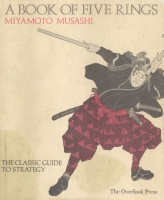kategóriák
- Közlekedés ajánlójegyzék
- Szocreál ajánlójegyzék
- Reklám ajánlójegyzék
- Fotó ajánlójegyzék
- Kínai-japán ajánlójegyzék
- Szentkép ajánlójegyzék
Új árakkal! - Új szentkép ajánlójegyzék II.
- 12 érdekes régiség
 Könyv
Könyv
 Bibliofilia
Bibliofilia
 Régiség
Régiség
 Metszet
Metszet
 Térkép
Térkép
 Fotó
Fotó
 Papírrégiség, Aprónyomtatvány
Papírrégiség, Aprónyomtatvány
 Plakát
Plakát
- Cirkusz
- Modern grafika
- Szocreál
- NER Irodalom
- Egyéb
kosár
üres a kosár
nincs bejelentkezve
Miyamoto Musashi : A Book of Five Rings
- leírás
- további adatok
The classic guide to strategy.
Translated by Victor Harris.
To learn a Japanese martial art is to learn Zen, and although you can't do so simply by reading a book, it sure does help--especially if that book is The Book of Five Rings. One of Japan's great samurai sword masters penned in decisive, unfaltering terms this certain path to victory, and like Sun Tzu's The Art of War it is applicable not only on the battlefield but also in all forms of competition. Always observant, creating confusion, striking at vulnerabilities--these are some of the basic principles. Going deeper, we find suki, the interval of vulnerability, of indecisiveness, of rest, the briefest but most vital moment to strike. In succinct detail, Miyamoto records ideal postures, blows, and psychological tactics to put the enemy off guard and open the way for attack. Most important of all is Miyamoto's concept of rhythm, how all things are in harmony, and that by working with the rhythm of a situation we can turn it to our advantage with little effort. But like Zen, this requires one task above all else, putting the book down and going out to practice.
Translated by Victor Harris.
To learn a Japanese martial art is to learn Zen, and although you can't do so simply by reading a book, it sure does help--especially if that book is The Book of Five Rings. One of Japan's great samurai sword masters penned in decisive, unfaltering terms this certain path to victory, and like Sun Tzu's The Art of War it is applicable not only on the battlefield but also in all forms of competition. Always observant, creating confusion, striking at vulnerabilities--these are some of the basic principles. Going deeper, we find suki, the interval of vulnerability, of indecisiveness, of rest, the briefest but most vital moment to strike. In succinct detail, Miyamoto records ideal postures, blows, and psychological tactics to put the enemy off guard and open the way for attack. Most important of all is Miyamoto's concept of rhythm, how all things are in harmony, and that by working with the rhythm of a situation we can turn it to our advantage with little effort. But like Zen, this requires one task above all else, putting the book down and going out to practice.
| állapot: |     |
| kategória: | Könyv > Sport > Harcművészetek > |
| kategória: | Könyv > Idegennyelvű könyvek > Angol nyelvű > |
| kiadó: | The Overlook Press, (2000) |
| cikkszám / ISBN: | 9780517415283 |
| kötés: | kötve/papír (kiadói, eredeti védőborítóban) |
| oldalszám: | 95 |
| könyv nyelve: | angol |









 Telefon:
Telefon: E-mail:
E-mail:







